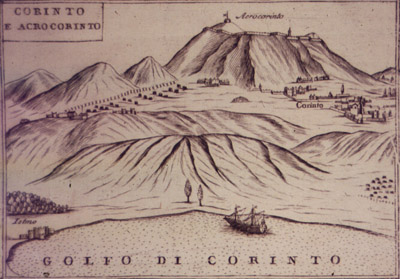
[Introduction]
[Methodology] [Greek and
Roman Corinth] [Modern Corinth] [Contributors]
[Reference] [News]
Introduction | Methodology | Timeline | Village Maps | Views | Temple of Apollo | Bazaar & Mosque | Bibliography
|
Figure 1 Coronelli, 1685: Courtesy of the Gennadius Library, American School of Classical Studies at Athens Introduction: The following discussion was researched and written by Leslie Kaplan (Ph.D., Department of Folklore, University of Pennsylvania, 2001). She spent two summers in Corinth, 1992 and 1993, as a field assistant for the Corinth Computer Project and served as a research assistant for the project during 1994--1995 researching this topic in the Gennnadius Library. The city of Corinth has been visited and studied since ancient times because of its fame and importance as an ancient Greek city-state and as a Roman colony. Pausanias's description of the archaic and classical splendors still visible in the Roman city has been a classic tourist guide from his own time to the present day. The interest in the city grew in the late Roman period because of the visit by St. Paul. Since that time, Corinth has been visited and studied by people looking right through the city of their time to the city of the past. Corinth is the site of the oldest American excavation in Greece, 100 years old in 1996. Early excavators dug quickly past the modern, Turkish, Byzantine, Medieval and Roman layers to uncover the "good stuff:" the archaic and classical Greek remains. Earlier this century, the Roman city became the focus of the scholarly efforts. Recently, under the direction of Dr. Charles K. Williams II, much attention has been paid to a section of the medieval city. This project is an effort to excite interest in and organize information about Corinth's later history, focusing on the late Ottoman period (17th century) to 1900. In the interest of clarity, it should be mentioned that the city of Corinth was destroyed by an earthquake 1858, and the city was moved to a site on the gulf of Corinth and renamed "New Corinth" to distinguish it from the village on the ancient site which is called "Ancient Corinth." For the most part, since this project is about Ancient Corinth, I have adopted the scholar's habit of referring to the village simply as "Corinth." There is a wealth of information about the city in the 18th and 19th century located in the many volumes of travel literature written by Europeans travelling through the area. These accounts contain information of use to scholars of the ancient cities, as they describe the landscape and ruins in an earlier state of preservation and change than modern excavators found them. The works are also useful for a view of Corinth (and Greece) in the 18th and 19th centuries as they contain a large amounts of topographical and ethnographic information. The travellers' descriptions and images represent a source of information that has yet to be properly mined for the wealth of information about the city, its history and the later fate of the ancient monuments that have attracted interest from the Roman period to the present day. This section of the Corinth Web Page will explore a small part of that later history through the images and text left to us by travellers to Corinth from 1671 to 1900. The focus of the page is driven by the concerns of the European travellers which mainly had to do with architecture, either ancient or exotic. More information and images can be found in the following sections (using the menu bar on the left): methodology, post-classical chronological sketch, maps of the 19th and 20th century villages, more views of Corinth from a distance, views of the Greek temple, views of the bazaar and central mosque or bibliographic information. Acknowledgements: I am most grateful to Dr. David Gilman Romano, director of the Corinth Computer Project, for allowing me, during the 7 months that I acted as his research assistant 1994-1995, to fuse his research agenda with my own interests and explore the later history of Corinth through such unorthodox sources as the anecdotal evidence offered by the travellers and their pictures and maps. I am indebted to him also for his continued interest in this more modern aspect of his project and his permission to use the slides, text and photographs I collected for him as well as his computer-generated maps. I am also grateful to the former Director 1966-1997 and Associate Director of Corinth Excavations, Dr. Charles K. Williams II and Dr. Nancy Bookidis for their help in gathering all the disparate bits of information on the later history of Corinth and their willingness to let me study them. I am also indebted to the current Director of the Corinth Excavations Dr. Guy Sanders for his interest in this project. The Gennadeion Library of the American School of Classical Studies at Athens which kindly granted me permission to photograph many of the images from their outstanding collection of travel literature and to reproduce them for this project. Finally, this project would not have been nearly so interesting had I not been (unknowingly) following in the footsteps of the Dr. Henry Robinson, who, during his tenure as Director of Corinth Excavations 1958-1966, collected an extensive library of photographs of illustrations from a variety of libraries in Greece and other European libraries, read through many of the travellers accounts I used, and located two town plans of Corinth from the immediate post-independence period. This information has been sitting, unexplored, in the Corinth Archives for 30 years. Though I didn't realize it until I was almost finished with my research in Greece, my research agenda was based on his, and benefited from the use of his sources which were collected over a much longer period of time than my own and from a wider variety of archives and libraries. |
© David Gilman Romano and the Corinth Computer Project.
Site design and maintenance by Dan Diffendale
